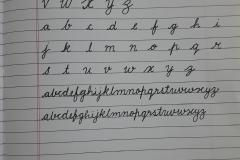A Handwriting Class Course typically offers instruction designed to improve and refine an individual's handwriting skills. Whether for personal use or professional development, these courses cater to learners of all ages and abilities, from children who are learning to write for the first time to adults who wish to enhance their penmanship. Here’s a detailed description of what such a course might include:
- Course Objective:
- The main goal of a handwriting class is to help students develop legible, consistent, and aesthetically pleasing handwriting.
- It can also address specific needs such as improving writing speed, developing a more professional-looking script, or correcting bad handwriting habits.
- Target Audience:
- Children: Help with foundational writing skills, fine motor skills, and letter formation.
- Students and Young Adults: Improve handwriting for note-taking, essays, exams, or professional communication.
- Adults: Focus on legibility, speed, and the development of a personalized handwriting style.
- Course Outline:
Introduction to Handwriting:
- Understanding the importance of good handwriting in personal and professional life.
- Setting up a comfortable workspace with proper posture, hand placement, and paper positioning.
Basic Handwriting Techniques:
- Grip and Posture: Proper pencil or pen grip, sitting posture, and the ideal position of the paper for optimal comfort and control.
- Letter Formation: Introduction to basic strokes (horizontal, vertical, curved), and how these form letters.
- Practice with Basic Alphabets: Working on both uppercase and lowercase letters, focusing on correct letter shapes and spacing.
Development of Writing Styles:
- Cursive Writing: A focus on connecting letters smoothly and naturally, creating a flowing script.
- Personal Style Development: Identifying and enhancing a personal handwriting style that is legible and unique.
Advanced Handwriting Skills:
- Spacing and Alignment: How to maintain uniformity in letter spacing, word spacing, and keeping lines straight.
- Speed Writing: Techniques to write quickly without sacrificing legibility.
- Writing for Specific Purposes: Examples of how to adapt handwriting for formal documents, creative writing, and other scenarios.
- Hands-On Practice:
- Students engage in exercises to practice individual letters, words, and entire sentences.
- Using worksheets that progressively challenge the learner’s skills, with practice on:
- Letter consistency
- Word flow
- Sentence structure
- Periodic assignments that focus on writing longer passages to improve fluidity and endurance.
- Feedback and Personalized Coaching:
- Instructors provide feedback on common errors such as inconsistent letter formation, poor spacing, or bad posture.
- Personalized guidance helps students address specific issues, for example, slanting of letters, irregular sizing, or awkward pen pressure.
- Specialized Topics:
- Calligraphy and Decorative Handwriting: Exploring decorative handwriting techniques such as different fonts, embellishments, and artistic lettering styles.
- Handwriting for Different Mediums: Writing on various surfaces (e.g., paper, chalkboard, whiteboard) and with different tools (pens, pencils, markers).
- Digital Handwriting: Transitioning handwriting skills to digital devices like tablets and stylus writing.
- Assessment and Evaluation:
- Regular assessments to measure improvement over time.
- Tests on letter formation, sentence fluency, and overall legibility.
- Some courses may offer certificates or recognition upon completion.
- Materials Used:
- Writing Tools: Pencils, pens (ballpoint, fountain, or gel pens), and markers.
- Paper: Lined and unlined paper, and specialized paper for handwriting practice (e.g., dotted or grid paper).
- Worksheets : Often provided to students to help them work through various exercises and drills.
- Duration and Format:
- The course duration is 15 Days but this may run over several weeks or months depending on the level of instruction and desired outcomes.
- Group Classes: Usually in small groups, offering peer interaction and collaborative learning.
- Private Sessions: One-on-one classes for more personalized attention and a faster pace of learning.
- Expected Outcomes:
- Students are expected to develop neat, consistent, and legible handwriting.
- An improvement in writing speed, reducing discomfort or fatigue while writing for long periods.
- Greater confidence in handwriting, especially for students who previously struggled with legibility.
- For professionals, a more polished and professional appearance of handwritten documents.
A handwriting class is an enriching experience that brings tangible improvements to one's writing abilities. Whether for students aiming for better academic performance or professionals wishing to leave a lasting impression with their penmanship, the course covers the full spectrum of handwriting improvement from basic skills to personalized handwriting styles.









